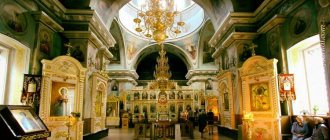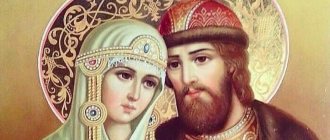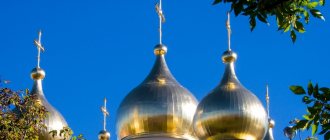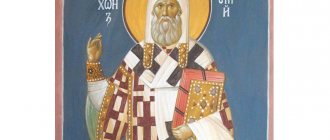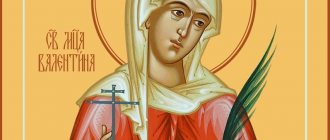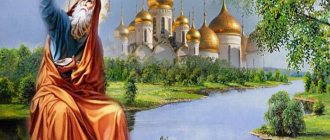| About the holiday | |
| Celebration date in 2021 | July 12 (Monday) |
| Name | Peter's Day |
| Other names | Petrovka, Day (Holiday) of the Sun, Yarilin's Day, Peter-Paul, Peter the Fishermen |
| Meaning | End of fasting, breaking the fast, beginning of haymaking |
| Who celebrates | Southern, Eastern Slavs |
| Type | Folk Christian |
| Traditions | They pray to the saints for health, attend services, walk, dance in circles, organize feasts and fraternities |
Significant for the Orthodox, the Feast of Peter and Paul, which falls during the hot July season, ends the Apostolic Lent.
This is a kind of milestone, the “top of summer,” the day of the supreme apostles, especially revered in Rus'. A huge number of rituals, signs, and traditions are associated with the celebration, which have been preserved since ancient times thanks to popular memory.
Apostle Peter
Before becoming a disciple of Christ, Peter was a fisherman. The Lord called Peter and his brother, the future Apostle Andrew the First-Called, when they were fishing on Lake Gennesaret.
It was Peter who was the first among the disciples to call the Teacher Christ, that is, the Messiah. For this, the Lord nicknamed him Stone (this is how the name Peter is translated). On this stone of Peter’s faith, the Lord promised to create His Church, which the gates of hell will not overcome.
When the high priests took custody of Christ before the crucifixion, Peter denied the Lord three times, as He had predicted to him. But Peter repented and atoned for his betrayal by becoming a fiery preacher of the faith of Christ. And, indeed, he served as the foundation of the Church - a community of faithful to the Savior.
After Pentecost - the descent of the Holy Spirit on the apostles - with his first sermon, Peter converted three thousand people to Christ. His missionary journey was accompanied by miracles and healings. Church Tradition says that Peter preached the Gospel along the shores of the Mediterranean Sea, in Antioch, Asia Minor, Egypt, Greece, Rome, Spain, Carthage and Britain.
Two Council Epistles of the Apostle Peter have survived to this day. They are included in the New Testament. Peter addresses his Epistles to Christians in the provinces of Asia Minor. Strengthens them in faith, warns them against the influence of false teachers.
The Apostle Peter predicted his martyrdom: “I know that I must soon leave my temple (body), just as our Lord Jesus Christ revealed to me.”
Towards the end of his life, Peter returned to Rome, and there he was captured and executed for preaching the gospel. This happened in 67. The apostle was crucified upside down at his own request: he considered himself unworthy to be crucified in the same way as the Lord.
Apostle Paul
Paul was not a disciple of Christ during the Savior’s earthly life. Moreover, Saul (as Paul was called before his conversion to Christianity) was a persecutor of Christians.
Saul was born in Asia Minor, in a city, many of whose inhabitants, being Jews, nevertheless had the rights of Roman citizens (which gave real privileges, the right to special state protection and consideration of any charges in the imperial, Roman court. For the Jewish people with their monotheism, this was a relatively rare phenomenon. He received a good education in Jerusalem and, apparently, was preparing for the position of rabbi. After completing his studies, he received the power to officially persecute Christians even outside Palestine - in Damascus.
It was on the road to Damascus that the Lord called Saul to apostolic service. During the journey, the future apostle was illuminated by a bright light, from which he fell blind to the ground. A voice came to him: “Saul, Saul, why are you persecuting Me?” To the question: “Who are you?” The Lord answered: “I am Jesus, whom you are persecuting.”
Christ commanded Saul to go to Damascus, where he would be told what to do next. Saul's companions heard the voice of Christ, but did not see the light. The blind Saul was brought to Damascus, taught the faith and baptized on the third day. At the moment of immersion in the water, Saul received his sight. From that time on, he became a zealous preacher of the Risen Christ.
The Jews were outraged by his conversion to Christ, and Saul had to flee to Jerusalem. There he joined the Christian community and met the apostles. And again the indignation of the Jews, threats of murder, from which Roman citizenship saved them.
But Jerusalem had to be abandoned. Saul went on his first apostolic journey, which lasted from 45 to 51 years. The apostles traversed the entire island of Cyprus, and it was during this period that Saul began to be called Paul. Together with Saint Barnabas, he founded Christian communities in several cities of Asia Minor.
Paul undertook several more apostolic journeys. He enlightened people in Macedonia, Greece and other lands with the teachings of Christ. Over the many years of his life and preaching, the Apostle Paul wrote 14 epistles; they are included in the New Testament.
Paul was arrested more than once and after his last imprisonment he suffered martyrdom by the sword. He was not crucified because he was not a slave, but a Roman citizen. This happened near Rome in 67, during the reign of Emperor Nero.
Orthodox Life
On July 12, the Orthodox Church prayerfully venerates the holy apostles Peter and Paul - two amazing preachers of the Gospel who became symbols of the first century of the Christian Church, two people whose writings the Church is still guided by in resolving various issues in the field of faith and morals, two people who are too different in their their origin and character, but united by a common faith in Christ and love for Him.
Apostles Peter and Paul. Icon by Archimandrite Zenon (Theodore)
The Holy Apostle Peter was from the small Jewish province of Galilee and, together with his father Jonah and brother Andrew, made a living by fishing. It was during his usual work on the shores of the sunny Lake Tiberias that he first heard the call that echoed in his heart and, bursting into his life, completely changed it. Christ the Savior addressed him, calling him and his brother to the feat of serving God and people. From now on, he became an apostle - that is, a messenger, a proclaimer of the will of the Savior and changed his family name Simon to Peter, which means “rock” and symbolizes the firmness of his faith.
Apostle Peter. Fragment of an icon. Byzantium. 6th century
From that time on, he inseparably follows the Savior of the world, listens to His instructions, teachings, fulfills His instructions, together with other disciples of Christ, going to cities and villages, preaching about Christ, healing the sick and helping all those who seek to find their way, their road to the eternal Truth. . He, along with James and John, was given the opportunity to experience the manifestation of the great glory of God on Mount Tabor, when the face of his Teacher and mentor shone with the uncreated Divine light, when the Lord showed his disciples his Divine glory as much as they could perceive it. Saint Peter saw not only the glory, but also the humiliation of his Lord. He witnesses the shameful, treacherous kiss of Judas and the outrage of Christ. And in this sorrowful moment he renounces Christ three times, committing the sin of betrayal. But Peter, unlike the traitor Judas, managed to find the strength to repent - and the risen Lord accepted his repentance, just as he now accepts the repentance of everyone who wants to correct their life and turn away from sin.
After the glorious Ascension of the Lord, the holy Apostle Peter sets out to preach about Christ, despite all kinds of sorrows and difficulties that he endured in his missionary labors. His letters and messages in the primal Church in the first years of the development of Christianity had unquestioned authority. He ended his sermon with martyrdom - during the reign of Emperor Nero he was crucified on the cross, and his last will was a very unusual request. Not considering himself worthy to die in the same way as His teacher, the apostle asked the executioners to crucify him upside down and thus completed his feat, betraying his soul into the hands of his God and Teacher.
Apostle Paul. Mosaic. Italy. 12th century
The Holy Apostle Paul was born in the rich and famous city of Tarsus and, although he came from a Jewish family, at birth he received the rights of Roman citizenship, which at that time gave the holder enormous privileges. Raised in strict adherence to the Old Testament ritual law, he received an excellent education in the capital of Judea, Jerusalem, at the school of the famous sage and scribe Gamaliel. During the earthly life of Christ the Savior, Saul, as Paul was then called, was still very small and, of course, could not see the Lord. Brought up in the spirit of devotion to the traditions of Judaism, he was hostile to Christianity. Saul approved the killing of the first martyr for Christ, Archdeacon Stephen. But the Lord, through a miraculous vision, called the former persecutor to preach. From the moment of his calling, Saul, having seen Christ in a wonderful light and heard his Divine voice, becomes a zealous preacher of Christianity. He repeatedly undertakes missionary journeys, proclaiming the truth about the risen Christ, and leaves as a legacy to the Church fourteen Epistles, which contain both lofty doctrinal truths and answers to practical questions. The Apostle Paul ended his sermon with a martyrdom - he was beheaded by the sword in Rome during the reign of Nero.
Apostles Peter and Paul. Mosaic. Italy. 5th century
And the day after the feast of the chief apostles, we will remember all twelve disciples of Christ. For many people living in a modern world that is far from Christian ideals, it may seem incomprehensible why the Church pays so much attention to the glorification of the apostles, why the feat of several unlearned people at the turn of the 1st century is so significant for everyone living in the 20th century, why we should glorify them and pray.
But if we take a closer look at the essence of their feat, we will realize how great and important the fruit that grew from the small seed of such a seemingly weak, quiet, but powerful and imperious apostolic preaching is. Let us, dear friends, think about what was the reason for such an inimitable success in the preaching of a handful of disciples of the wandering Palestinian Preacher? What made the ancient world, shuddering in the convulsions of narcissistic, selfish dying, believe those who preached about the crucified and suffering Righteous One? Why did the Roman patricians, shining with grace and luxury, and the poor and despised slaves, rich matrons and cruel legionnaires, sophisticated Greek philosophers and semi-wild barbarian tribes, obeying the power of the Word, accepted the teaching that had previously seemed so incomprehensible and absurd, and began to be called hitherto unknown? name - Christians.
Firstly, their endless confidence in the preached and proclaimed truths played a role here. They really saw God's Love incarnate, they really witnessed the Resurrection from the dead and could not help but proclaim this joyful and good news, the news of the deliverance of all people through the Resurrection of Christ from the power of sin, curse and death.
Secondly, the words of their preaching never diverged from their deeds. They strove not only in teaching, but also in everyday life to be a model for everyone. And the ancient environment could not resist, contemplating their pure, moral life amid debauchery, deception, lies and hatred. The pagan world, choking from the stench of sin, sought holiness and found it; it found this holiness in Christianity, seeing the pure and sinless life of its preachers.
Thirdly, and this point is probably the most important, the holy apostles in their missionary labors were always invisibly but effectively accompanied by the gracious help of God. The Lord Jesus Christ, ascending into heaven, to the heavenly Throne of God's glory, left promises to His disciples and apostles to remain with them “all the days until the end of the age,” that is, always, until the last day of human history, when this age ends and everyone enters life of the next century. And this false Divine promise was fulfilled by the apostles. The power of their preaching lay not in the persuasiveness of rhetoric, not in sophistic philosophical delights, but in the revelation of Divine power, in the breath of the Good Comforter of the Holy Spirit filling their preaching. God Himself spoke through the mouth of His apostles. And the hearts of people, created in the image and likeness of God, heard this divine spirit, which was breathed by the inspired words of the apostolic sermon, and responded to it. The reflection of heavenly light that burned in the eyes of the apostles ignited human souls - and many, leaving a reckless attachment to sin, strove for holiness, for the implementation of Christian ideals in their own lives, tried to fulfill the commandments of God, and drew closer to Christ.
Apostles Peter and Paul. The bottom of a ritual vessel. Glass, gold. The Roman Empire. IV century
If it were not for this gracious help, then a few uneducated Galilean poor would not have been able to conquer the whole world for their Crucified Teacher; the apostles, who were once hiding from fear of the malice and envy of the Jewish elders, would not have been able to denounce powerful nobles and all-powerful rulers with such fearlessness and call for repentance sinners, heal the weak and give health to the sick, instruct and comfort his large flock. The Lord always helped the apostles, and we hope that He, in His great mercy, will help each of us.
Archpriest Andrei Nikolaidi
History of the celebration of Peter and Paul Day
Historians do not have a consensus on the date of death of the apostles Peter and Paul, but there is a certain church tradition. Saint Demetrius of Rostov (author of the collection of lives of saints - “Cheti-Minea”) writes that the death of the apostles occurred either on the same day, or with a difference of exactly one year.
The appearance of the holiday of Peter and Paul is also associated with the day of the transfer of their relics in Rome, which took place on July 12 (June 29, old style) in the year 258.
In 324, under Emperor Constantine, the first churches in honor of Peter and Paul were built in both capitals of the Roman Empire, Rome and Constantinople. Since then, the holiday began to be celebrated even more solemnly and gradually became one of the most famous Orthodox holidays.
Service to the Supreme Apostles Peter and Paul
Currently, in Orthodoxy, the feast of Peter and Paul is one of the great ones, equated to the Twelve. On this day, Peter's fast ends, which began a week after the Trinity Day. But if the holiday falls on Wednesday or Friday, then only fish is allowed.
Stichera for the service of Peter and Paul were written in the 7th–8th centuries by Patriarch Germanus , St. Andrew of Crete , St. John of Damascus , Cosmas of Mayum and other Orthodox hymnographers.
Part of the stichera is addressed simultaneously to Peter and Paul:
Thou hast given the establishment of Thy Church, O Lord, to Peter's firmness, and Paul's mind, and bright wisdom, and to both the true voice of God, driving away Hellenic charm. Moreover, we secretly teach from both, we sing to You, Jesus Almighty, Savior of our souls.
Translation: “The establishment of Your Church, O Lord, You gave strength to Peter and Paul, reason and bright wisdom, and to both the true divine preaching, driving away the deception of godlessness. Therefore, we, taught by both of them the mysteries of the Divine, sing to Thee, Omnipotent Jesus, Savior of our souls.”
Other stichera are addressed only to Peter:
The third question is: Peter, do you love Me? Christ corrected the third rejection. Likewise, to the Mystic Simon: Lord, you know everything, you know everything, you know how much I love you. Also to him the Savior: feed my sheep, feed my chosen ones, feed my lambs, who have provided my blood for salvation. Pray to him, God-blessed apostle, to grant us great mercy.
Translation: “Three times: “Peter, do you love Me?” Christ corrected the threefold renunciation. That’s why Simon answered the One Who Knows Secrets: “Lord, You know everything, You know everything, You know that I love You!” Then the Savior turned to him: “Feed My sheep, feed My chosen ones, feed My lambs, whom I purchased with My own blood for salvation!” Pray to Him, God-blessed Apostle, to grant us great mercy.”
There are also such stichera in the service that are addressed to Paul alone:
Even though your bonds and sorrows are all over the city, who can say, the glorious Apostle Paul? Works, illnesses and vigils, even in greed and thirst for malice. Even in winter and nakedness, a knives and beating rods. Throwing stones and contempt. Depths of incineration. It's a shame to be an Angel and a man. You have endured all slaughter in Christ who strengthens you, so that you may gain peace in Christ Jesus your Lord. Moreover, we pray to you, who faithfully create your memory, pray unceasingly for our souls to be saved.
Translation: “Who can list your bonds and sorrows in all your cities, O glorious Apostle Paul? Works, struggles, vigils, sufferings of hunger and thirst, cold and nakedness, baskets and blows with sticks, stoning and contempt of people, the depths in which one drowned in a shipwreck. You have become a spectacle for Angels and people. You have endured everything for Christ who strengthens you, so that you may win the whole world in Christ Jesus your Lord. Therefore, we ask you, commemorating your memory with faith: Pray unceasingly for the salvation of our souls.”
Greatness to the holy apostles:
We magnify you, Apostles of Christ Peter and Paul. Who enlightened the whole world with their teachings and brought everyone to Christ.
During the evening service on the eve of the holiday, paremias are read - excerpts from the conciliar letter of the Apostle Peter. Since the texts of the New Testament book are being read, those praying listen to them standing (usually you can sit during the proverbs). At Matins, two canons written by St. John of Damascus (8th century) are read. One canon is addressed to the Apostle Peter, the other to Paul.
Library of the Russian Faith Canon to the Holy Apostles Peter and Paul →
Read online
Peter and Paul Day in Rus'
The Slavs began to honor the day of Peter and Paul immediately after the Baptism of Rus'. As Church Tradition says, the first icon of the holy apostles was brought to Russian soil by the holy Equal-to-the-Apostles Prince Vladimir - from Korsun. Then this icon was presented as a gift to the Novgorod St. Sophia Cathedral, where frescoes from the 11th century depicting the Apostle Peter have been preserved to this day.
The first monastery in honor of the supreme apostles was built in Novgorod in 1185. Many saints of Ancient Rus' bore the names of the apostles, and images of Peter and Paul can always be seen in the iconostasis of Orthodox churches.
Popular beliefs
There are many popular beliefs, legends and omens associated with Peter and Paul. Simple peasants endowed them with fabulousness.
Different Slavic peoples have developed their own ideas about the apostles.
- Everywhere among the people, Peter and Paul were perceived as a paired character - Petro-Paul, as well as Kuzma and Demyan (Cosma and Damian).
- In Bulgaria they were considered brothers. The younger Peter was kind and did not prohibit garden work on his day. The elder Pavel was known as a stern and strict brother. He could punish those who worked on holiday with thunder and lightning.
- People said that the brothers kept the keys to heaven. Peter guards the Garden of Eden with the Tree of Eden.
- According to Hutsul belief, in the spring Saint Yuri takes the keys from Peter. When they find themselves again with Peter, autumn comes.
- In Serbia, Peter was depicted riding a deer with golden antlers. Here they believed that the faith was divided into Orthodox and Catholic because the apostles quarreled. Peter said that he was Orthodox, and his brother, Paul, decided to be a Catholic.
There is a story among Belarusians about how the Apostle Peter stole a horse from Christ. Jesus called the raven and the cuckoo to testify, and asked whether Peter stole the horse or bought it? To which the crow replied: “stole, stole,” and the cuckoo replied: “ku-drank, ku-drank.” For the truth, the Lord allowed the crow to caw all year, and punished the cuckoo to be silent on St. Petersburg Day. Therefore, she only croaks until mid-summer.
Iconography of the Feast of Peter and Paul
Already in the first icons, the apostles Peter and Paul were often depicted together. First frontally, and from the 16th century - facing each other. This iconographic plot symbolized the creation of the New Testament Church.
On the icon, the Apostle Peter is depicted extending his right hand in a prayer gesture. In his left hand there is a scroll and a key on a long chain: “...and I will give you the keys of the kingdom of heaven” (Matthew 16:19).
A book is depicted in the hands of the Apostle Paul, which recalls that he is the author of the fourteen epistles included in the New Testament.
Cities named after the apostles
Several cities also bear the name Petropavlovsk. One of them, founded on July 12, 1752 as a military fortress, is now located in Kazakhstan. Trade routes from Russia and Central Asia converged here. At the end of the 18th century, the Sultan of the Middle Kyrgyz Horde Vali took the oath of allegiance to the Russian government in the Peter and Paul Fortress. In 1896, the Petropavlovsk station of the Trans-Siberian Railway was built near the city. In 1920, the Kyrgyz Republic was formed, later the Kazakh Autonomous Soviet Socialist Republic, to which Petropavlovsk was included. It is worth noting that this city was not renamed during the Soviet years.
Petropavlovsk is also the name of one of the very first Russian cities in the Far East. Ostrog was founded by the Cossacks in 1697. In 1740, the Bering expedition arrived here, the ships of which were named “ St. Apostle Peter ” and “ St. Apostle Paul ”. On the site of the fort, a settlement was founded, which is now the capital of Kamchatka - the city of Petropavlovsk-Kamchatsky.
The meaning of the day of Peter and Paul
Archpriest Igor Fomin, rector of the Alexander Nevsky Church at MGIMO.
If we pay attention to all four multi-day fasts of the year, we will see that each fast is designed to ensure that we prepare for the holiday of transition. The transition either from temporary life to eternal life, or, conversely, the descent from eternal life to earth. For example, the Nativity Fast leads us to the day of the Nativity of Christ - the day when God came into the world as a helpless baby to save us.
At the end of Peter's Lent - July 12, on the day of the holy supreme apostles Peter and Paul - we will remember their death, their transition to eternal life. They went to the Lord with a difference of only one year. These people are two great lamps of our faith, it was through them that Christianity mainly spread throughout the world.
Traditions of Peter's Day
Preparations for the celebration began in advance: they kept a fast, cleaned their home and yard the day before, cooked food, and painted eggs yellow. They tried not to leave urgent matters for the holiday, in order to devote it entirely to service, prayers, and celebration.
The day before, everyone went out to the outskirts of the village, lit fires, cooked porridge, treated themselves, sang songs all night, danced, and in the morning they waited for the sun to rise to see the first rays and make a wish. It was believed that on this day the sun “plays”, shines in a special way, and the wished-for, if you see the very first ray, will come true. At dawn, the girls picked flowers in 12 fields - one from each, put them under the pillow, wishing that they would dream about their betrothed.
On the holiday, believers attended services at which they remembered the deeds of the apostles, their earthly affairs, prayed for the health of their relatives and loved ones, and asked for healing for those sick with fever. When visiting a temple, they always left refreshments for the church members, the orphans, and the homeless. After the service, they gathered at the same table with their relatives, ate dishes that were forbidden to be consumed during Lent, and then went to games and festivities, not forgetting to leave food for wanderers near the house.
As a rule, in every village there were large swings, and the young men, trying to swing the highest, received the right to make a wish to the participants in the game. Youth games were also popular, when guys blocked the road with barrels and tubs in order to quickly catch up with the girls running away from them.
It was customary to organize large fairs, where craftsmen sold their products, and merchants surprised them with overseas goods. In shopping areas in large settlements one could watch theatrical performances.
The last summer weddings took place under the auspices of the apostles. A union established on such a day should be long, friendly, and happy. Then weddings took place in the fall, when the crops were harvested from the fields, and nothing interfered with the celebration.
Traditional rituals:
- They brought vegetables and fruits to the church and gave them to wanderers in need so that the year would be rich in harvests;
- to protect domestic animals from various kinds of evil spirits and diseases, a bright red ribbon was tied to their horns;
- fishermen bought a large candle together, lit it near the icon of Peter and asked for good luck;
- early in the morning at sunrise, the peasants walked together to the spring to wash their faces and bodies and gain health, beauty, and be cured of illness (they had to go around three springs);
- the girls found a young birch tree, wove a braid from three branches, made a wish and said: “In the name of the Father and the Son and the Holy Spirit!”;
- to ensure a prosperous life, borscht made from fresh herbs and young cockerel meat, and a fish dish were placed on the festive table;
- For the sweet life, children were baked buns (mandriki) filled with cottage cheese and fruit.
Prayer to Saint Apostle Peter
O Saint Peter, great apostle, self-witness and companion of God, received by the omnipotent right hand of your Teacher from the troubled waters and extreme drowning! Do not forget us, the poor, stuck in the mire of sin and drowned by the waves of the sea of life, give us your strong hand, help us and keep us from drowning in passions, lusts, lies and slander. Do with us the mercy shown to you by the Lord, so that we do not give in to doubt and lack of faith. Teach us, our teacher, to shed a tear of repentance, so that we may weep bitterly for our deeds in this world. And if your tears, poured out in repentance, are covered by His mercy, the Lord and your Teacher, ask for us, with apostolic boldness, forgiveness in the turmoil of our hourly renunciation of Christ. Preserve this city, cast down at your holy feet, and protect our salvation from the wily machinations of the enemy of our salvation; Raise up your reverend hands to the Lord for our people, so that we may live a quiet and silent life in this world until the hour to which the Master Lord, our unwashed Judge, will call us. But you, O all-praised apostle, do not reject our cry and groaning to you about our intercession before Christ, so that we may glorify His mercy towards us together with the Father and the Holy Spirit. Amen.
Prayer to Saint Apostle Paul
O holy supreme Apostle Paul, the chosen vessel of Christ, the teller of heavenly mysteries, the teacher of all languages, the church trumpet, the notorious orbit, who endured many troubles for the name of Christ, who measured the sea and walked the earth and turned us from the flattery of idols! I pray to you and cry to you: do not disdain my foul (name), raise up the one who has fallen through sinful laziness, just as you raised the temple in Lystra from your mother’s womb; and just as Eutychus, who was dead, was revived, raise me also from dead deeds; and just as with your prayer you once shook the foundation of the prison and you allowed the prisoners to do the will of God. For all you can do by the authority given to you from Christ God, to Him belongs all glory, honor and worship, with His Beginning Father, and with His Most Holy and Good and Life-Giving Spirit, now and ever and unto the ages of ages. Amen.
Folk traditions of Peter and Paul Day
Among the people, the feast of the holy supreme apostles Peter and Paul had many names: Peter-Paul, Petrok, Peters and Pauls, Worldly Candle, Green Mowing, Red Summer, Play of the Sun, Peter the Fishermen, Fisherman, Peter's Day, Petrovka and many others.
In Rus', July 12 was considered the holiday of fishermen, because before being called to the apostolic ministry, Peter was a fisherman. On Peter's Day the spring season ended and the summer fishing season began. In some regions, on July 12, they collected money for a large wax candle - “Peter the Fisherman for a Worldly Candle.” A candle was placed in the temple in front of the image of the apostle.
On the eve of the holiday, the village youth went to the field, walked there all night, “watching for the sun,” and greeted the dawn. As people believed, the sun on the day of Peter and Paul was special: it played with different colors, shimmered like a rainbow.
Old Believer Peter and Paul Churches
The tradition of building and consecrating churches in the name of the apostles Peter and Paul was preserved in the Old Believers. Today is the patronal holiday in the communities of the Russian Orthodox Old Believer Church in Yakutsk, Dzerzhinsk, Nizhny Novgorod region, village. Afanasyevo, Kirov region, village. Russian Tavra, Sverdlovsk region, village. Krasnokamenka district Crimea. The temple holiday is also in the Belokrinitsa parishes of Romania: in the cities of Sulina, Piatra Neamt and Iasi.
Church of the Russian Orthodox Church St. apostles Peter and Paul. Afanasyevo
Church of the Russian Orthodox Church in the name of Peter and Paul in the village. Russian Tavra Sverdlovsk region
Church of the Holy Apostles Peter and Paul. Krasnokamenka
The patronal holiday is also celebrated by the communities of the Russian Ancient Orthodox Church in the city of Primorsko-Akhtarsk, Krasnodar Territory, Volsk, Saratov Region, Kasli, Chelyabinsk Region, village. Mozharki of the Chuvash Republic and the village. Shurma, Kirov region. In honor of the apostles Peter and Paul, the Pomeranian churches of the Dubyansk, Stripishki and Radviliski communities (Lithuania) were also built.
Church of the Russian Children's Center in the name of Peter and Paul in Kasli, Chelyabinsk region
The feast of Peter and Paul has long been revered in the community of the Russian Orthodox Old Believer Church in the village of Strelnikovo, Kostroma region, where there is a procession of the cross, as on the patronal feast of the Intercession of the Virgin.
Cathedral of Saints Peter and Paul in the Peter and Paul Fortress
Construction of the Cathedral of Saints Peter and Paul in St. Petersburg began a few years after the foundation of the Peter and Paul Fortress (1703). According to legend, Peter I personally determined the location for the future temple, placing crisscrossed pieces of turf in the center of the fortress.
The first church on this site was made of wood. The stone building of the cathedral was erected by the Italian architect Domenico Trezzini. The temple was built from 1712 to 1733. The first stone in its foundation was laid by the emperor himself, the second by Empress Catherine.
The bell tower of the Cathedral of Peter and Paul is crowned with a gilded 34-meter spire with a clock. In 1725, the spire was decorated with the figure of an angel with a cross in his hand.
The carved iconostasis of the Peter and Paul Cathedral was made in 1721-1725 by the famous architect of the Peter I era, Ivan Zarudny. And the icons for the iconostasis were painted by Andrey Merkuryev and Fyodor Artemyev.
In 1830, a 23-year-old peasant from the Yaroslavl province, Pyotr Telushkin, climbed the bell tower to fix the damaged cross that crowned the spire. Pyotr Telushkin volunteered to do this work using a rope loop: it was too expensive to build scaffolding. Having wrapped the loop around the base of the spire and tied it around him, in the presence of a huge crowd of people he rose to the very base of the cross and, having made the necessary repairs, safely descended back. For this feat, Pyotr Telushkin was awarded a silver medal “For Diligence.”
Numerous military trophies were kept in the Peter and Paul Cathedral - banners, weapons, keys to captured fortresses and cities. The tombs of all Russian emperors, starting with Peter I, with the exception of Peter II and Ivan Antonovich, are also located here.
Peter and Paul churches and monasteries
For a long time in Russia, churches were built in the name of the Supreme Apostles Peter and Paul . Perhaps the oldest one has been preserved in Smolensk. It was built in 1140-1150 by a princely artel. Simeon, the first Smolensk bishop, consecrated. Subsequently, the temple was rebuilt several times, the original appearance was restored by P.D. Baranovsky. The church, built of brick, is an example of a cross-domed single-domed ancient Russian temple. Smolensk masters continued the traditions of Kievan Rus and Byzantium. This temple is similar to those of Vladimir-Suzdal and early Moscow, but some decorative elements resemble examples of Novgorod and Pskov architecture.
Church of the Apostles Peter and Paul on Gorodyanka in Smolensk. Built in 1146
Several ancient churches in honor of the apostles Peter and Paul have survived in Veliky Novgorod. At the end of the 12th century, the Church of Peter and Paul was built on Sinichya Mountain . Its construction was carried out in 1185-1192. Perhaps the temple was built on the site of an older one. It had a convent and a cemetery. This place was located outside the city. The monastery was attacked by the Swedes in 1611. In 1764 the monastery was abolished. From 1925 to the present day, the temple has been inactive and is in disrepair. In 1992 it was included in the UNESCO World Heritage List.
Church of Peter and Paul on Sinichaya Mountain. Velikiy Novgorod
Another church is the Church of the Holy Apostles Peter and Paul in Kozhevniki , built in 1406. This is a single-domed, four-pillar Novgorod church on Bredova-Zverina Street, near the southern part of the former Zverin Intercession Monastery.
Church of the Holy Apostles Peter and Paul in Kozhevniki. Velikiy Novgorod
The Church of Peter and Paul on Slavna was built in 1367, next to the Old Believer Church in the name of the Prophet Elijah (Znamenskaya St.). Now the church is abandoned.
Church of Peter and Paul on Slavna. Velikiy Novgorod
the Peter and Paul Monastery in 1275 , where he himself took monastic vows, leaving his reign. Under Catherine II, the monastery was deprived of all land and it fell into disrepair. Abolished in 1830. Later the monastery was restored as a women's dormitory. Several residential buildings and the Cathedral of the Presentation of the Virgin Mary, built at the beginning of the 18th century on the site of an old wooden church, have survived to this day.
On the shore of Lake Onega in the village of Povenets in 1600, a cathedral was built in the name of the Supreme Apostles Peter and Paul. Abolished around 1945.
Cathedral of Peter and Paul in the village. Povenets. Drawing from the magazine “World Illustration”
In Pskov there is a temple of Peter and Paul from Buya . Initially, a temple stood on the site of the existing church in 1373; the building was restored in 1540 at the convergence of the main streets of the city. The temple was erected on the site of the oldest city cemetery - Buya, near the fortress wall of the middle city. In 1810, two dilapidated chapels and a belfry were dismantled, and a porch was added to the western porch.
Church of Peter and Paul in Pskov
, the temple of the former Sirotkin Monastery in Pskov was consecrated . The temple dates back to the 15th - second quarter of the 16th centuries. The architectural design of the building is very interesting: it is typical Pskov in general, it is original in composition, which includes various buildings from different periods. The ancient quadrangle with a rather wide apse adjoining it from the east strings onto its axis from the west - a vestibule, a refectory, a bell tower, stretching out in a line. From the north, along the entire length of this line, later extensions adjoin the temple complex: a chapel in the name of the Dormition of the Blessed Virgin Mary, behind it are three rooms along the same east-west axis, corresponding to the size of the refectory and porches of the main church; the large apse of the chapel (close in proportions to the altar semicircle of the ancient church - a rare example in Pskov of a 2-part system of a balanced plan). The restrained high-rise accents of the bell tower with a spire and the onion dome are also mutually balanced. The decor of the southern facade is unique: crosses made of stove glazed tiles. The decoration of the head drum with a runner and a curb is typically Pskov. After the abolition of the monastery in 1764, the Peter and Paul Church was transferred for perpetual use to the Pskov Diocese of the Russian Orthodox Church.
Temple in the name of the Holy Apostles Peter and Paul of the former Sirotkin Monastery in Pskov
In the name of the holy apostles Peter and Paul, a temple was consecrated on the island of Lychny Lake. Sandalwood of the Kondopoga region of the Republic of Karelia . The temple was built in 1620. According to data from 1831, there were two churches and a bell tower on the Lychnoostrovsky churchyard. Over its long life, the Church of Peter and Paul changed its appearance significantly. So, for example, in the middle of the 18th century, instead of a vestibule, a refectory with new vestibules was installed. At the same time, the main volume of the church was supplemented with a second octagon. In subsequent years, the original appearance of the monument was not completely restored: there is no bell tower with a covered passage to the church. In the 2nd half of the 17th century. - 1st half of the 18th century. a hipped roof was added, and later a separate hipped bell tower and a new refectory were built, the walls were lined with planks. In 1872, the bell tower was moved to the temple. During the Civil War, it was damaged during the fighting, the tent was destroyed, and later the bell tower was broken. In 1951-1956. restored in 18th century forms. In 2003-2004 The structures were strengthened using compression.
Temple in the name of the Holy Apostles Peter and Paul on the island of Lychny Lake. Sandalwood of the Kondopozhsky district of the Republic of Karelia
In the name of the holy apostles Peter and Paul, a temple was consecrated in the Povenets urban settlement of the Medvezhyegorsk region of the Republic of Karelia . The temple was built in 1600. From the article “Tercentennial anniversary of the first Povenets Church” in the Olonets Diocesan Gazette No. 13-14 for 1900: “... the Povenets Church was built, the builder of which, as the records in the clergy registers of the Povenets Cathedral say, was Schemamonk Anoim and Novgorod merchants.” . The temple was destroyed during the Great Patriotic War.
Temple in the name of the Holy Apostles Peter and Paul in the Povenets urban settlement of the Medvezhyegorsk region of the Republic of Karelia
In the name of the holy apostles Peter and Paul, a cathedral was consecrated in the village of Selizharovo, Tver region . The stone Church of Peter and Paul was erected no earlier than the end of the 16th century as the refectory of the Trinity Selizharovsky Monastery. Therefore, at the temple there was a grain store, a cookhouse, cellars, a drying room, a kvass room, a government room, a cellar room and cellars. The Peter and Paul Church with the Guryev chapel was located on the second floor of a two-story building - a prototype of the Faceted Chamber of the Moscow Kremlin. In 1762, the altar was expanded and the window openings of the building were rebuilt. In the 1930s, the temple was closed and destroyed, the premises were rebuilt into a store. The temple was returned to believers in 1992.
Cathedral in the name of the Holy Apostles Peter and Paul in the village of Selizharovo, Tver region
In the name of the holy apostles Peter and Paul, a temple was consecrated in the city of Kamenets-Podolsky, Khmelnitsky region of Ukraine . The first documentary evidence of the Peter and Paul Church dates back to the end of the 16th century. There is information that in 1591 a house was donated to this church by the Kamenets tradesman Ivan Seletsky. The stone, three-masked, three-conch church had a tower over the Babinets. Fragments of frescoes from the 16th century have been preserved in the interior. During the period of Turkish rule, the Church of Saints Peter and Paul was given to the Roman Catholics for their services. In the 18th century, the Peter and Paul Church was Uniate. In 1795, the church was returned to the Russian Orthodox Church.
Temple in the name of the Holy Apostles Peter and Paul in the city of Kamenets-Podolsky, Khmelnitsky region of Ukraine
Fortress of Peter and Paul (Peter and Paul Fortress)
The history of St. Petersburg began with the foundation of the Peter and Paul Fortress. In 1703, at the mouth of the Neva, on Hare Island, Peter I “renewed this fortress for its state name with the nickname Petersburg.”
Initially, the fortress was built from earth and wood, and in 1706–1740 it was rebuilt into stone. The architect was the Italian Domenico Trezzini. The bastions and curtains, made of brick and stone, were up to 12 meters high and 20 meters wide. The fortress was surrounded by moats filled with water.
Since 1924, the Peter and Paul Fortress has become a historical and revolutionary museum. Now it is a branch of the Museum of the History of St. Petersburg.
